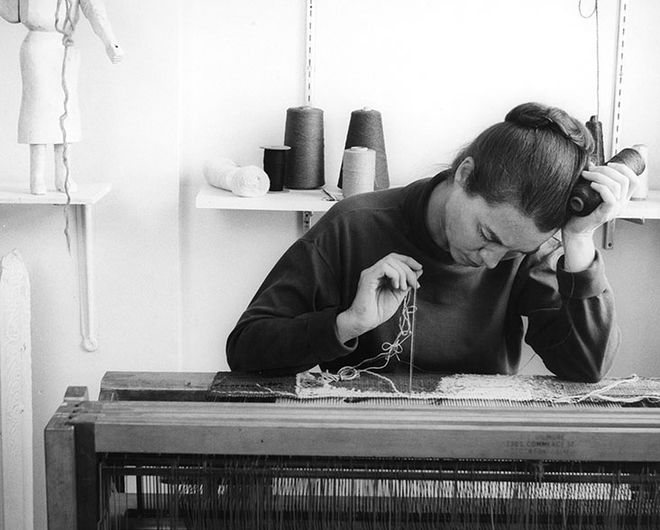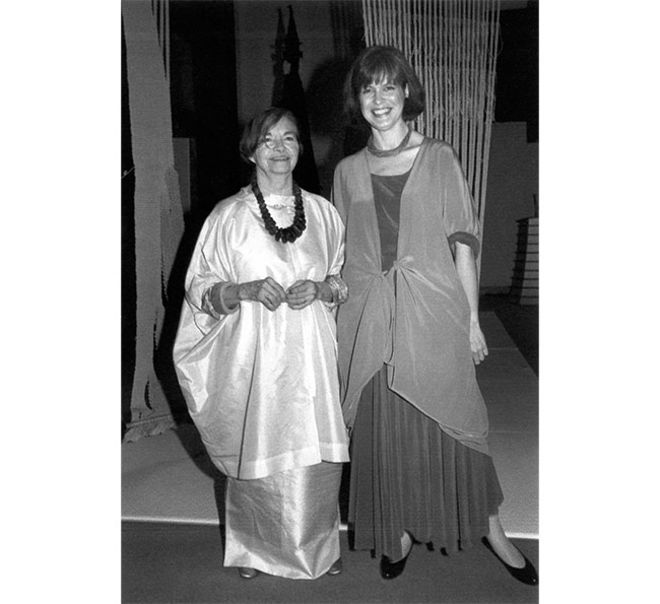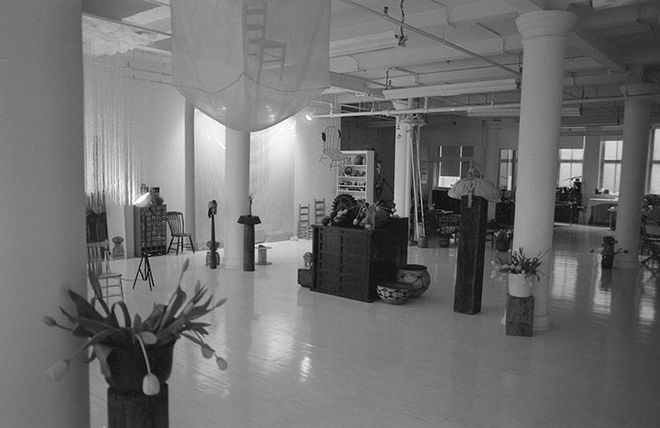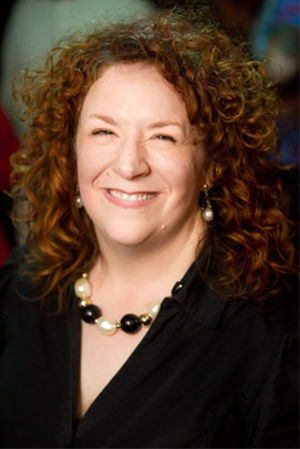
Lenore Tawney in her Chicago studio, 1957. Photo: Aaron Siskind.
In 2023, the Lenore G. Tawney Foundation established an endowed scholarship at Bard Graduate Center to support a student pursuing research in textiles history. It is a gift that honors the Foundation’s long relationship with Bard Graduate Center and its students, spanning back to its earliest days.
Lenore Tawney (1907–2007) was an American artist known for her groundbreaking work in textiles as well as for her drawings, collages, and assemblages. Tawney’s innovative work was at the vanguard of what came to be called fiber art during the second half of the twentieth century. Her groundbreaking sculptural weavings range from intimate to monumental in scale and reflect both the originality of her vision and her sensitivity to the expressive potential of the medium.
Tawney established her foundation in 1989 for charitable and educational purposes, and she endowed it with her life’s resources, artistic and financial. The Foundation supports the visual arts with a focus on craft media, including fiber art. Its broad aim is to increase public access to and knowledge about the visual arts and to support learning opportunities for emerging artists.
Recently, Amy Estes, director of marketing and communications at Bard Graduate Center, sat down with Kathleen Mangan, an independent curator and executive director of the Lenore G. Tawney Foundation, to learn more about Tawney’s life and work and the new scholarship established in her name.
Amy Estes: Thank you for taking the time to talk with me today. In preparation for this conversation, I did some research about Lenore Tawney, and she sounds like an amazing person. I’m sorry that I didn’t know of her work until now.
Kathleen Mangan: She was an amazing person, Amy, and I feel so fortunate to have known her well for the last twenty years of her life. Recognition of her work has grown, especially over the past ten years. She is still an underrecognized artist, but it’s been my experience that when people become more acquainted with her work, with what she did and when she did it, it opens up new appreciation.

Lenore Tawney and Kathleen Mangan, American Craft Museum, 1990.
AE: She was really a trailblazer, wasn’t she?
KM: Very much so. That brings to mind something that the artist Jack Youngerman said when Glenn Adamson interviewed him for the major biographical essay published in Lenore Tawney: Mirror of the Universe, in conjunction with Tawney’s 2019 retrospective at the John Michael Kohler Arts Center. Youngerman knew Tawney from their Coenties Slip days in the late 1950s. He said that all of the artists working there were outliers, but even among this community of artists, people didn’t really understand what she was doing, and perhaps because she was a weaver, there wasn’t the same level of appreciation [as for people practicing other art forms]. In retrospect, Youngerman thought Lenore was the greatest outlier of them all. That admiration took time to grow.
AE: And she only came to New York and began her art career at the age of fifty?
KM: Yes, she reestablished herself as an artist and produced this extraordinary body of work during the remaining fifty years of her life.
AE: I find that both aspirational and inspirational.
KM: She broke ground as an artist and as a woman, and also by establishing her foundation as early as she did, in 1989, with the idea that it would inherit her work and her assets when she passed away. At that time, there were certainly artist-endowed foundations being established, but not so many by women artists. She had a conviction, a belief in herself and her work, and that was the motivating force that led her to establish the foundation. She was the president, and it only existed as an entity on paper for a few years. The board formed in the mid-1990s, and one of the board members, Paul J. Smith (director emeritus of the American Craft Museum, now the Museum of Arts and Design, who passed away in 2020), asked a series of questions that he hoped would guide us when Lenore was no longer present. He asked her to outline her priorities for the foundation. Because we are a small foundation, there is a limit to what we can do, and it must be focused in a way that aligns with her intentions. She was very clear about what she did and did not want the foundation to do with its resources, and her top priority was the establishment of scholarships for artists and young scholars.
AE: How did you become familiar with Bard Graduate Center?
KM: The board member I mentioned, Paul Smith, was already connected with BGC, and he and I invited associate professor Catherine Whalen to bring her class to Lenore’s loft. It was wonderful because nothing had been touched, so the students were able to have a real studio visit and see that environment. It was a 4,000-square-foot loft that created a very otherworldly experience, stepping off the elevator and into that space with her artworks and all of the collections that she had amassed over her lifetime. It was at that point that we began discussions with Catherine about the possibility of BGC students working with us to help bring some clarity to this mass of material. We advertised for a summer intern, and we had such an enthusiastic response that we actually had three BGC MA students from the class of 2011 work with us—Lauren McDaniel, Rebecca Klassen, and Kate Fox—and they all stayed for a couple of years.
AE: Wow, they were deeply invested in the project.
KM: Yes, and we have a functioning archive as a result of their efforts. Lauren McDaniel had a background in library sciences, and she did an extraordinary job of pulling Lenore’s personal papers into coherence, an experience she recently wrote up. (McDaniel’s article, “Archiving in the Clouds: Processing the Lenore Tawney Collection,” was published by Los Angeles Archivists Collective.) That touched me very much. Rebecca Klassen worked on Lenore’s collection of black and white archival photographs, which is so important to documenting her early works and early years. And Kate Fox helped us pull all of the other information we had into a database. It was an incredible experience, and I am still in touch with all three of them.
AE: How fabulous that they had such an impact!

Lenore Tawney’s studio, 1985. Photo: Paul J. Smith
KM: Through that connection, I started thinking that down the line, it would be wonderful to establish a scholarship at BGC. We initially established several scholarships at art schools for students working in textiles. And then Lenore’s wishes were that we would support other kinds of projects like exhibitions, catalogues, and so forth. In more recent years, especially during the pandemic, arts organizations have really needed help to get through challenging times, so the Foundation has supported them. Hopefully, we’ve gotten through most of that, and we have begun looking toward the future and thinking, “What did Lenore really task us to do with our assets?” It was time to return to her desire to fund scholarships, and the fund we have endowed at BGC is the first new scholarship that we have established. I thought of it as a way of paying forward what those BGC students did for us in establishing this archive.
AE: One thing that I have noticed about students of textile arts at BGC: so often, they are both scholars and makers. It seems like the perfect intersection of Tawney’s desire to support practicing artists and share the history of the field.
KM: I am very proud to be encouraging future scholarship in the field.
AE: And we at BGC are so thankful for your support of our students! As Benjamin Krevolin, BGC’s chief advancement officer, said, it is a real honor to have a bit of the Tawney legacy here at BGC.

